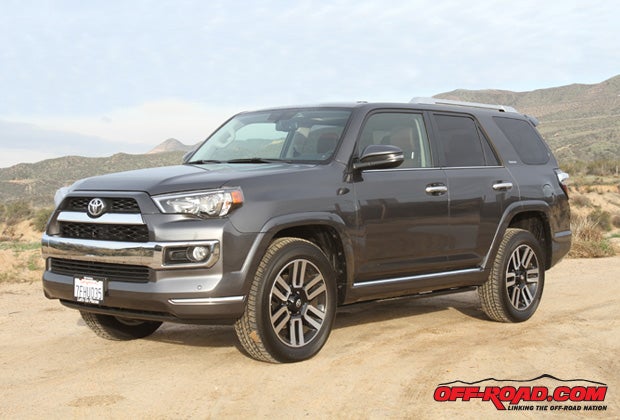
Sadly, as the years go by it isnít uncommon for a seminal OEM off-road vehicle to lose touch with the original design parameters that made it so great in the first place. Not unlike the musclecar market, the off-road market is littered with once proud model badges that have been tainted by diminished trail worthiness via the addition of such fluff as fancy bodywork and luxurious interior appointments that add weight and/or rob performance.
Fortunately for fans of Toyotaís 4Runner, the vaunted platform has remained true to its roots through five generations and more than 30 years as a staple of the companyís 4x4 offerings. Granted, Toyota has taken the opportunity to broaden the 4Runnerís appeal to soccer moms, power ties and other non-off-roaders by offering increasingly opulent trim packages and (gasp) even selling the 4Runner with a two-wheel-drive powertrain. But even in its most extravagant trim level, the Limited 4X4, the 2015 Toyota 4Runner is at its core a truly off-road-worthy machine.
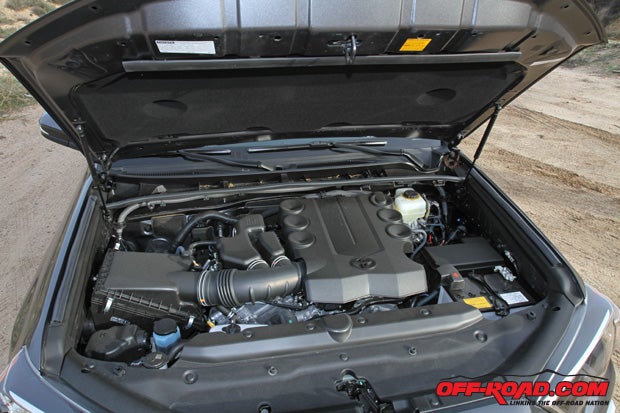
Off-road capability is in the 4Runnerís DNA. Back when it was introduced in 1984, the 4Runner was little more than a modified Toyota SR5 4x4 pickup with a back seat and a removable roof similar to those of the Ford Bronco and the Chevrolet Blazer. As the SUV market evolved, however, so did the 4Runner. In 1989, the second generation 4Runner was released with a V6 engine along with a permanent steel roof and four full doors, effectively turning it into Toyotaís version of a Suburban instead of a Blazer. Subsequent generations have continued to retain the basic design features of the gen-II 4Runners while still remaining true to the spirit of the originals.
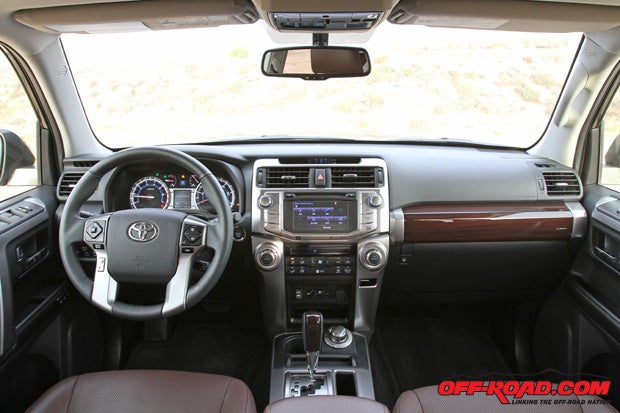
For instance, in a world where unibody SUVs have proliferated, the 4Runner clings to the good old-fashioned, pickup truck-style body-on-frame design. Toyota believes that its old-school, boxed ladder frame still makes for a better off-road platform because it resists twisting forces in the off-road environment. Thatís a good quality to have when crawling over rocks or fording gullies, and a ladder chassis also stands up better under the stresses of towing, although it often comes at the expense of excessive body roll on the road. The 4Runner tames the road or the trail through four coilspring shock absorbers mated to an independent double-wishbone suspension with a sway bar up front and a solid axle with a four-link system and a sway bar out back.
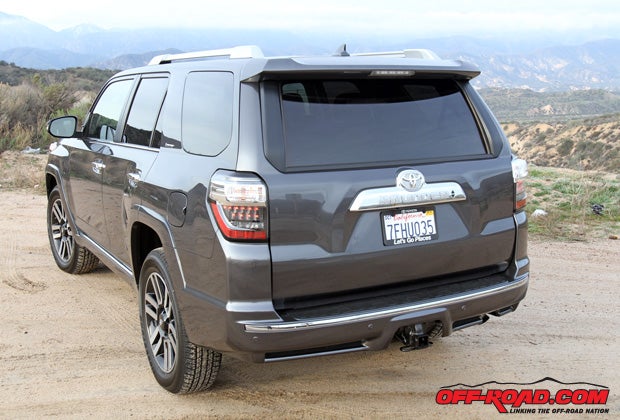
A hearty chassis deserves a hearty powertrain, and all 4Runners boast Toyotaís fuel-injected, DOHC, 24-valve V6 with Independent Variable Valve Timing, which boasts a rating of 270 horsepower at 5,600 rpm with 278 lb.-ft. of torque at 4,400 rpm. Itís worth noting that the 4Runnerís tune-up yields 34 more horsepower and 12 lb.-ft. more torque than the same engine fitted in the Toyota Tacoma that was part of our 2015 Mid-Size Truck Shootout, but the 4Runner is also about 300 lbs. heavier, checking in with a claimed curb weight of 4,708 lbs.
Power is transmitted through an electronically controlled (ECT) 5-speed automatic transmission. Our Limited test unit came equipped with a full-time 4WD system with Toyotaís Active Traction Control (A-TRAC) system and Torsen 1 limited-slip locking center differential. Perilous terrain can be negotiated simply by rotating a dial to activate the 4Runner Limited 4x4ís dual range (high/low) transfer case, which can distribute 40 percent of the engine torque to the front wheels. The system offers three modes: H4F for everyday street driving, H4L for off-road use in the transfer caseís high gear range with the differential locked, and L4L for crawling over terrain in with the transfer case in low range and the differential locked. The 4Runner Limited 4x4 also features Hill Start and Downhill Assist Control to aid less experienced off-roaders when climbing or descending.
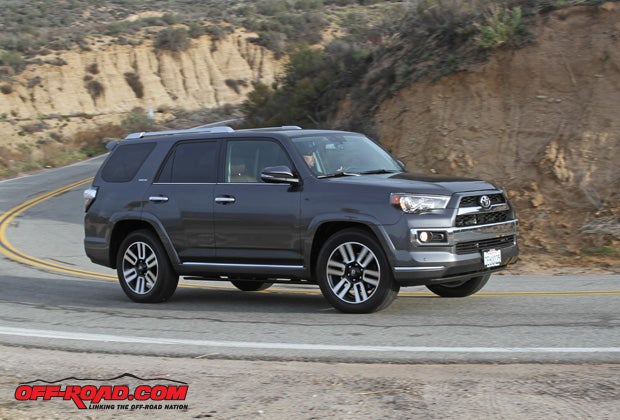
Toyota V6s are renowned for making excellent low-end torque, and our 4Runner didnít disappoint during acceleration testing. Aided by its low 3.52 first gear and 3.71:1 axle ratio, the 4Runner practically matched the numbers recorded by its sibling, the Toyota Tacoma, during our 2015 Mid-Size Truck Shootout. The 4Runner accelerated from 0-60 mph in an identical 8.79 seconds and just barely outran the Tacoma in the quarter mile, posting a best of 16.75 seconds at 85.43 mph. On the street, the 4Runnerís willingness to zip away from a stoplight or cleanly pass slower traffic when cruising on the highway gained our respect, and it does this all without excessive engine noise creeping into the cabin.
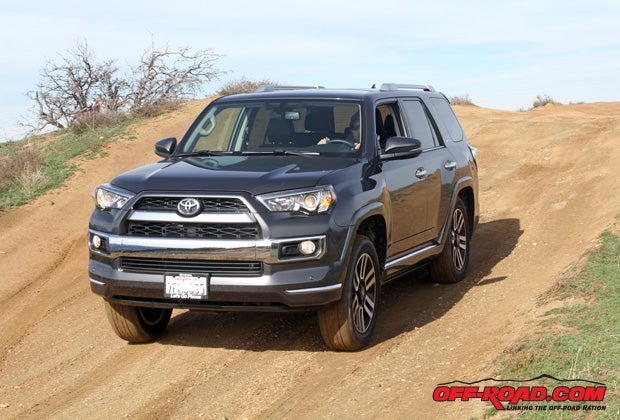
On the flip side, our measured fuel economy was just a shade below the 4Runnerís EPA fuel economy numbers. Even though we paid careful attention to the 4Runnerís instrument cluster-mounted ďECO modeĒ bar graph, which encourages fuel conservation by letting the driver know when he or she is driving in the most fuel efficient manner, our fuel mileage averaged 16.6 miles per gallon. Thatís below the 4Runnerís claimed 18 mpg. Based on our fuel numbers, the 4Runnerís 23-gallon fuel tank would yield a calculated range of 381.8 miles before going bone dry.
And believe us when we say, if youíre buy a 4Runner Limited 4x4, youíre going to want to drive it. We were instantly spoiled by its excellent handling and smooth ride in the city and on the highway. The 4Runnerís power-assisted rack-and-pinion steering offers delightful steering manners with a tight, solid feel for a near-5000-lb. vehicle when rounding corners at a brisk pace.
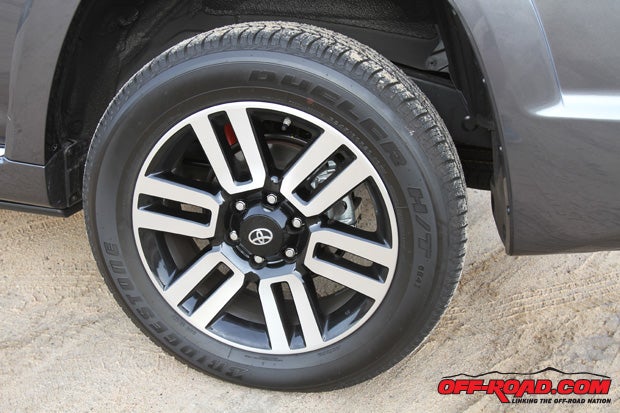
In fact, we expected more body roll from the 4Runner than we experienced, but suspension is one area where the Limited versionís extra features are worth its steeper price tag. Toyota fits the Limited with its X-REAS (X-RElative Absorber System) Sport Enhancement Suspension. The X-REAS system helps to keep the 4Runner body flatter when cornering by cross-linking the front and rear shocks, i.e., transferring oil from the inside rear wheel shock absorber to the outside front wheel shock absorber. A central control absorber is used to cross-link the shocks. Itís an expensive system that can hurt you in the wallet when repair or replacement is required, but it works extremely well.
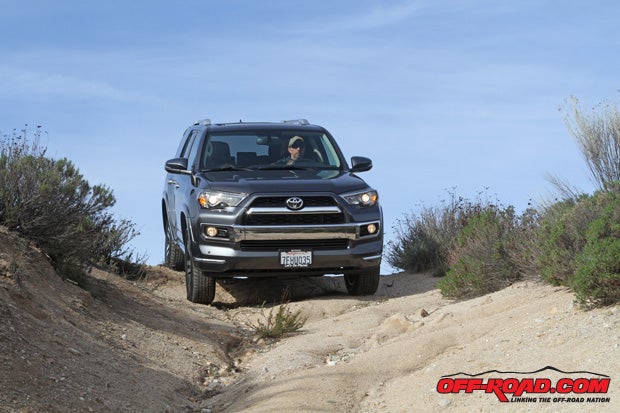
We liked the X-REAS even more once we left the pavement. The Limitedís suspension is surprisingly composed when the going gets rough, offering an impressive degree of plushness and bump control without bucking and hopping through high-amplitude bumps. In fact, we had an American truck with its full ďoff-roadĒ trim package along with us during our test driveóremember what we said about badge-onomics? The 4Runner was able to scamper away in moderate to rough chop every time, leaving the so-called big, tough truck bouncing around in its wake. No doubt about it, the 4Runner exudes confidence in the rough stuff, and it delivers.
But while the 4Runner is an ideal off-road platform, the 4Runner Limited 4x4 is not the ideal trim level for knocking around in the boonies. Right off the bat, the Limited is handicapped by its dual six-spoke 20-inch alloy wheels and street-oriented Bridgestone Dueler H/T P245/60 R20 tires. This rolling stock is great for bounding down the highway, but thereís precious little sidewall between the ground and the rim, and that makes it a real liability in rocky terrain. It definitely muted our fun during our off-road test loop even though we were impressed with the Duelerís abilities to maintain decent traction in the dirt and mud, even while climbing.
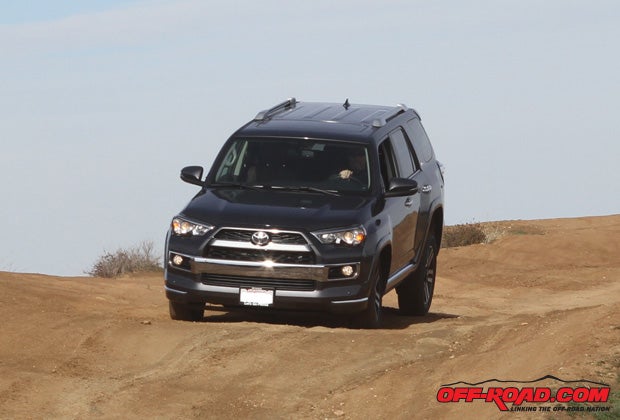
Braking is one aspect of the 4Runneróand its other mid-sized siblingsóthat we are not found of. We figured that the Tacomaís rear drum brakes were part of the reason that its brakes lacked the linear action and smooth feel at the pedal feel that we expect from a Toyota. However, it was more of the same with the 4Runner Limited 4x4, which is fitted with disc brakes at all four corners. The braking action has a servo-like feel to it that we simply donít care for. Granted, the 4Runnerís standard ABS consistently delivers added peace of mind during the occasional panic stop or under heavy braking on low-traction surfaces, but weíre still convinced that the 4Runnerís braking system is over-boosted and in dire need of refinement.
Thereís certainly no need to refine the 4Runnerís spacious interior, which pampers both the driver and passengers whether on grocery runs or long trips. Up front, its Lexus-like interior includes perforated leather front bucket seats that are both heated and ventilated, offering three heating and three cooling settings for each seat. The driverís seat also offers powered eight-way adjustability with memory functions and power lumbar support, and the passengerís seat offers four-way adjustability. Keeping the interior temperature comfortable is no sweat (pardon the pun) thanks to the 4Runner Limitedís dual zone automatic climate control system, which also works with the second-row vents. The Limited also features a power tilt/slide moonroof with sunshade, and we all know how the chicks dig Ďem. Up to seven passengers can be accommodated thanks to the Limitedís generous third-row seating, and both the second- and third-row seating can be folded down to create up to 88 cubic feet of cargo. When not folded flat, the seatbacks recline for added passenger comfort. Weíve lived in apartments that werenít this nice.
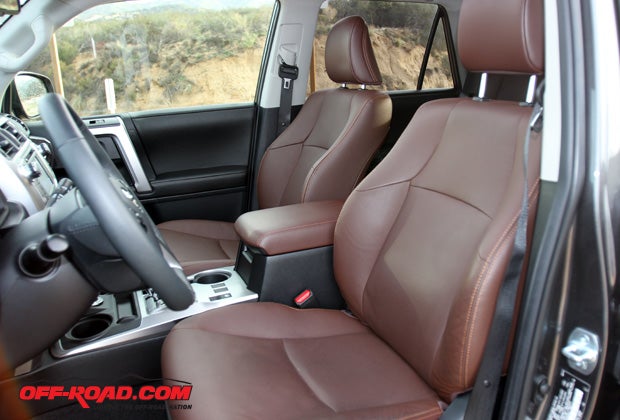
Thereís a comfortable ergonomic flow to the 4Runnerís interior as well. Its analog-style gauges, which include a large-faced 120 mph speedometer and a 7000 rpm tachometer are easy to read, and so is the digital display that lies between them. Toyota offers electronic gadget users a lot of places to power-up, fitting socket-style power outlets inside the center console, on the backside of the center console and next to the heated seat controls at the bottom of the dash, along with a single jack-style adapter and a USB port for the stereo. However, we would have liked at least one 120-volt style outlet up front. The 4runner has one, but it is located in the package area on the passenger side at the very rear of the vehicle.
The 4Runnerís Entune Premium JBL Audio stereo system is state-of-the-art, featuring Navigation3 and App Suite4, which allows the user to do everything from accessing myriad of trip computer functions to enjoying multiple satellite and internet radio stations, making dinner reservations or buying movie tickets, all by scrolling through the various menus on the Limited 4x4ís 6.1-in. high-resolution touch-screen display. The system also features excellent voice recognition software to allow the driver to focus on the road while using the system.
Of course, the 4Runnerís exterior is still as sharp as ever. Our Limited 4x4 was swathed in a beautiful magnetic gray metallic paint, and it boasted a few extra frills, such as heated power outside mirrors with turn signal indicators. It also featured retractable power steps that, honestly, we feel are unnecessary due to the 4Runner Limitedís proximity to the ground. If the body or suspension were lifted, weíd love Ďem, but with the stock ride height our testers found them to be a bit of a nuisance, as we wanted to step past them, only to bang our calves on them every time we exited the vehicle.
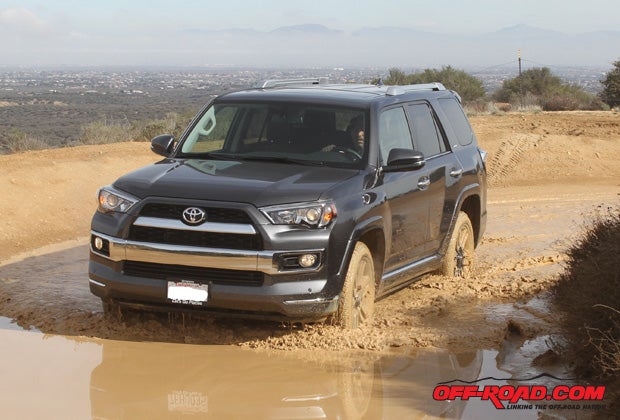
Thereís no question that at the end of the day the Toyota 4Runner Limited 4x4 deserves a very good rating for its street comfort and its true off-road potential. Itís already quite capable in the sticks, and weíre sure we could mitigate the compromises Toyota made to enhance the Limitedís street prowess by opting for 18-inch wheels and more aggressive tires. However, doing so would leave us with one posh off-road rig that would still set us back over $46,000. As much as we like that X-REAS suspension system, we know we could find just as much happiness in a lesser-equipped 4-Runner, especially if we planned to spend a fair amount of time exploring the outback.
Still, thereís no denying the cool factor of the 2015 Toyota 4Runner Limited. Affluent business types with a wild hair to do some occasional off-roading will find its appointments and its capabilities to be a perfect match. Weíd suggest taking full advantage of what the Limited has to offer by scheduling your next board meeting at the top of the nearest mountain.
Specifications Ė 2015 Toyota 4Runner Limited
Engine: 4.0-liter, V6, DOHC, 24-valve with variable valve timing
Horsepower: 270 hp @ 5,600 rpm
Torque: 278 lb.-ft. @ 4,400 rpm
Transmission: 5-speed ECT automatic
Height: 70.1 in. (as tested wo/roof rack)
Track Width: 63.2 in. (front), 63.2 in. (rear)
Length: 190.7 in.
Wheelbase: 109.8 in.
Approach Angle: 33 degrees
Departure Angle: 26 degrees
Breakover Angle: N/A
Ground Clearance (suspension or axle to ground): 9.6 in. front, 9.6 in. (rear)
Claimed Curb Weight: 4,805 lbs.
Gross Vehicle Weight Rating: 6,300 lbs.
Towing Capacity: 4,700 lbs.
Payload Capacity: 1,495 lbs.
Fuel Tank: 23.0 gal.
Seating Capacity: 7 (as tested w/third-row seating)
Axle Ratio: 3.727:1
Aver. MPG (tested): 16.6 mpg overall
Price: $46,170*
*Sticker price as tested, includes destination charges


 Your Privacy Choices
Your Privacy Choices